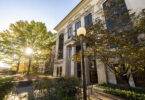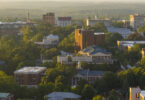UGA students are getting their hands dirty at the UGArden on South Milledge Avenue… They’re picking okra off 7-foot-tall plants, harvesting the last of the summer crop of tomatoes, raking a patch for a new herb garden and tilling the land to plant fall crops.
UGArden is a student organization formed last year to bring a community garden to campus. This summer, students planted their first crop on a little less than an acre of UGA land near the greenhouses and across from the old red barn. They harvested tomatoes, cucumbers, corn, watermelon, cantaloupe, green beans, peppers and okra-some for their own use-and donated more than 500 pounds to the Foodbank of Northeast Georgia.
“I’m really interested in the local food movement, and I thought it would be a fun thing to do to have something like this at UGA,” said Jenny Brickman, co-president of UGArden, while she picked okra in the garden.
She said she saw community gardens at other universities and thought it was something UGA could use.
Though the approximately 20 people who showed up for fall planting day were mostly students, volunteers included UGA faculty, staff and alumni-even local master gardeners have gotten involved to lend the students their expertise.
A certificate program in local food systems in also in the works and should be approved by next fall, according to David Berle, associate professor of horticulture and UGArden club adviser, who was helping to get the fall portion of the garden prepared at the workday.
UGArden’s land, which is zoned for agricultural use, was secured through the College of Agricultural and Environmental Sciences, whose officials knew that the animal and dairy science’s swine unit would be moving out of the space. The land had the added bonus of access to classroom space, bathrooms and storage facilities for harvested crops and equipment.
Once the garden’s location was finalized, the Physical Plant helped clear the ground for the garden and install irrigation. They also donated compost, along with the dining commons new food waste compost program.
At the fall planting workday, Berle instructs a group of students to measure out 60 feet to prepare six or seven rows to plant lettuce, spinach and other fall crops.
The garden’s other two plots, one for summer and one for spring, will be in cover crop for the fall. Berle explained that they’ll plant crimson clover on those plots to keep the weeds down and enrich the soil with organic matter.
“[The garden is] meant to be a place for students who aren’t in traditional agriculture programs to get some hands-on experience gardening,” he said. “All the students want to learn different things. I’m just trying to make sure that the growing part that they learn is based on current knowledge and research on sustainable practices. Pretty much, I’m just trying to help make sure they grow things right.”
The garden opened this summer and this workday was the garden’s busiest yet. During fall semester the garden will have Tuesday and Saturday morning work sessions. For more information on the UGArden, e-mail or subscribe to the UGArden list serv at www.listserv.uga.edu.






